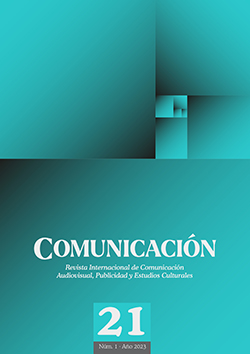Abstract
The black comedy film is a subgenre of comedy that is gaining more and more relevance among audiences. Álex de la Iglesia is a Spanish director, screenwriter and producer who works in this subgenre for the approach of his stories. The aim of this paper is to analyze three of his most relevant cinematographic works in order to identify representative themes of black comedy, obtained from the bibliographic exploration of the subgenre. For the exploration of the object of study, a qualitative approach has been proposed from the analytical-synthetic methodology, using the technique of content analysis. The study concludes that Álex de la Iglesia uses each of these categories in the three films, not so much as an aesthetic purpose, but to generate a critique of social and value systems, and to generate reflection on the issues raised, beyond what can be seen superficially.
References
Al-Hussainawya, A. A. F. (2020). The Prevalence of Black Comedy in Comic Plays of Post-postmodern Drama: Sarah Ruhl's The Clean House as a Sample. Prevalence, 13(7), 561-975. https://ww.ijicc.net/images/vol_13/Iss_7/13778_Hussainawy_2020_E_R.pdf
Blake, M. (2015). Writing the comedy movie. Londres: Bloomsbury Publishing.
Breton, A. (2007). Antología del humor negro. Barcelona: Anagrama.
Buse, P., Toribio, N. T. y Willis, A. (2013). The cinema of Álex de la Iglesia. Manchester: Manchester University Press.
Byron, S. y Weiss, E. (1977). Movie Comedy. New York: Viking Press.
Castelli Olvera, A. K. (2021). Representaciones mediáticas del imaginario social y la heroína mítica en la película El Bar de Álex de la Iglesia. Xihmai, 16(32), 127-166. https://doi.org/10.37646/xihmai.v16i32.527
Cerdán Martínez, V. (2018). La belleza de “lo feo”: narrativa y estética en el documental “The Act of Killing”. En J. Herrero y M. Trenta (Eds.), X Congreso Internacional Latina de Comunicación Social. Comunicación y música: mensajes, manifestaciones y negocios (pp. 647-661). Sociedad Latina de Comunicación Social. https://doi.org/10.4185/cac144
Connard, S. (2005). The Comedic Base of Black Comedy. An Analysis of Black Comedy as a Unique Contemporary Film Genre. (Tesis de Maestría, University of New South Wales). https://www.unsworks.unsw.edu.au/primo-explore/fulldisplay/unsworks_37509/UNSWORKS
Coppin, M. y Gaspard, J. L. (2017). El humor negro frente a la muerte. Desde el jardín de Freud: Revista de psicoanálisis, (17), 149-160. https://doi.org/10.15446/djf.n17.65522
Eaton, M. (2013). Dark Comedy from Dr. Strangelove to the Dude. En A. Horton y J. E. Rapf (Eds.), A Companion to Film Comedy (pp. 315-339). Malden: Wiley Blackwell Publishing Ltd. https://doi.org/10.1002/9781118327821.ch15
Echavarría, J. D., Ramírez Gómez, C. A., Zuluaga Aristizábal, M. U. y Ortiz Vanegas, J. (2010). El método analítico como método natural. Nómadas. Revista crítica de Ciencias Sociales y Jurídicas, 25(1), 1-27. https://revistas.ucm.es/index.php/NOMA/article/view/NOMA1010140327A/25986
Fernández Riquelme, S. (2017). Si las piedras hablaran. Metodología cualitativa de Investigación en Ciencias Sociales. La Razón Histórica. Revista hispanoamericana de Historia de las Ideas, (37), 4-30. https://n9.cl/p39hm
Gehring, W. (1999). Parody as Film Genre: “Never Give a Saga an Even Break”. Londres: Greenwood Publishing Group.
Herrera, C. D. (2018). Investigación cualitativa y análisis de contenido temático. Orientación intelectual de revista Universum. Revista general de información y documentación, 28(1), 119-142. https://pdfs.semanticscholar.org/6b9f/8f8f7c3c89b76f6d191c7089f17960f16903.pdf
Marsh, S. y Nair, P. (2004). Gender and Spanish cinema. Oxford: Berg Publishers.
Matrundola y O’Neale. (2002). Black Comedy, Genre Report. Los Ángeles: UCLA.
McGraw, A. P., Williams, L. E. y Warren, C. (2014). The Rise and Fall of Humor: Psychological Distance Modulates Humorous Responses to Tragedy.Social Psychological and Personality Science, 5(5), 566-572. https://doi.org/10.1177/1948550613515006
Palmer, J. (2016). The logic of the absurd: On film and television comedy. London: British Film Institute.
Pérez, N. (2010). La intertextualidad en el cine de Álex de la Iglesia: el caso del cómic. Fotocinema. Revista científica de cine y fotografía, (1), 39-73. https://doi.org/10.24310/Fotocinema.2010.v0i1.5850
Pogel, N. y Chamberlain, W. (1985). Humor into Film: Self Reflections in Adaptations of Black Comic Novels. Literature/Film Quarterly, 13(3), 187-193. https://www.jstor.org/stable/43797445
Rodríguez Jiménez, A. y Pérez Jacinto, A. O. (2017). Métodos científicos de indagación y de construcción del conocimiento. Revista Escuela de Administración de negocios, (82), 175-195. https://doi.org/10.21158/01208160.n82.2017.1647
Ruiz Zaragoza, B. (2014). El lado luminoso del humor negro. Sincronía, (65), 92- 103. http://sincronia.cucsh.udg.mx/pdf/2014/ruiz_65.pdf
Russo, F. (2017). Críticas salvajes. Crítica social, emancipación y comedia negra. Revista de Estudios Sociales Contemporáneos, 18, 82-94. https://ri.conicet.gov.ar/handle/11336/99060
Sánchez Laílla, L. (2019). La tragicomedia, un problema sin resolver de la exégesis aristotélica. Studia aurea: Revista de literatura española y teoría literaria del Renacimiento y Siglo de Oro, 13, 361-417. https://doi.org/10.5565/rev/studiaaurea.354
Street, A. (2018). Dramatic Measures: Comedy as Philosophical Paradigm. Anglia, 136(1), 75-99. https://doi.org/10.1515/ang-2018-0010
Torres, C. (2016). Esperpento e intertextualidad en el cine de Álex de la Iglesia. Printemps. (9), 199-216. https://iberical.sorbonne-universite.fr/wp-content/uploads/2016/05/Pages-from-Iberic@l-no9-printemps-2016-18.pdf
Vásconez Merino, G. y Carpio Arias, F. (2020). La estética posmoderna en el cine: una aproximación teórica. Kairós. Revista de Ciencias Económicas, Jurídicas y Administrativas, 3(5), 52-61. https://doi.org/10.37135/kai.03.05.05
Vásconez Merino, G. (2021). Elementos de contexto y temáticas representativas de la comedia negra cinematográfica. En N. Sánchez-Gey y M. L. Cárdenas-Rica (Coords.), La comunicación a la vanguardia: Tendencias, métodos y perspectivas (pp. 3151-3168). Fragua.
Vásconez Merino, G., Carpio Arias, F. y Carpio Salas, J. (2022). Representación de la mujer en filmes de comedia negra: un análisis a través de la Teoría del sexismo ambivalente. Investigaciones Feministas, 13(1), 435-446. https://doi.org/10.5209/infe.79680
Vera, C. y Badariotti, S. (2002). Cómo hacer cine: El día de la bestia de Alex de la Iglesia (Vol. 131). Madrid: Fundamentos.
Voytilla, S. y Petri, S. (1959). Writing the Comedy Film: Make 'em Laugh. Burbank: Michael Wiese Productions.

This work is licensed under a Creative Commons Attribution-NonCommercial-ShareAlike 4.0 International License.
Copyright (c) 2023 Galo Vásconez Merino, Antonella Carpio Arias, Nicolás Carpio Arias

